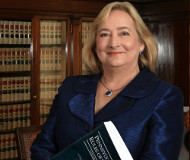11/29/2017
Pennsylvania Supreme Court Rejects Idea That Looking At GPS Is SuspiciousMotorists should not be subject to a police interrogation for pulling over to program their GPS, Pennsylvania Supreme Court rules.

Pulling over to use a GPS navigation system does not constitute reasonable suspicion to conduct a traffic stop. That was the finding of the Pennsylvania Supreme Court in a ruling Monday that examined the June 14, 2013 arrest of a woman who had stopped on the shoulder of Interstate 79 to type in a street address.
When state trooper Jeremy Frantz saw Victoria Livingstone's car on the shoulder around 9:30pm, he flipped on his emergency lights to find out whether the driver needed help. He pulled alongside and became suspicious because Livingstone gave him what he called a "hundred mile stare." Livingstone told the trooper that she was fine and needed no help.
The trooper continued, and over the course of intensive questioning, Livingstone told the officer a number of curious things. She said she was on the way to New York to attend a dragon boat race and that she was the CEO of "five companies." Her rambling tipped off the officer that she might be drunk -- a fact later confirmed by a blood test. She was booked for under the influence (DUI).
The high court majority, however, found that the trooper had no business subjecting a citizen stopped on the roadside to such an extensive interrogation. The patrol car's flashing emergency lights, the majority reasoned, created a situation that was not a "voluntary" conversation as the prosecution had insisted.
"Upon consideration of the realities of everyday life, particularly the relationship between ordinary citizens and law enforcement, we simply cannot pretend that a reasonable person, innocent of any crime, would not interpret the activation of emergency lights on a police vehicle as a signal that he or she is not free to leave," Justice Debra McCloskey Todd wrote for the majority.
Prosecutors insisted that the lights were merely used for safety purposes and that this was not an arrest. The justices felt otherwise since a motorist who guesses wrong and drives away from a patrol car with lights flashing risks being charged with a crime.
The high court held that a police officer cannot escape the Fourth Amendment requirement to have a warrant to seize an individual unless he can point to specific, objective and articulable facts suggesting an emergency exists. A car on the side of the road is not such an emergency.
"There are many reasons why a driver might pull to the side of a highway: the driver may need to look at a map, answer or make a telephone call, send a text message, pick something up off the floor, clean up a spill, locate something in her purse or in his wallet, retrieve something from the glove compartment, attend to someone in the back seat, or, as in the instant case, enter an address into the vehicle's navigation system," Justice Todd wrote. "Pulling to the side of the road to perform any of these activities is encouraged, as a momentary distraction while driving may result in catastrophic consequences."
A copy of the ruling is available in a 300k PDF file at the source link below.


